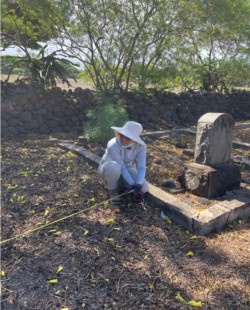Marking the Past
By Jack Kiyonaga, Editor

Photo courtesy of Christina Mello.
A project that is mapping unmarked graves in Kamalo is bringing names and histories to those buried there.
The St. Damien Burial Council invited UH researchers to help document gravesites at St. Joseph’s and Our Lady of Seven Sorrows churches at the behest of former pastor Father Brian Guerrini back in 2020.
Molokai resident Pat Tancayo has worked closely with the project since its inception.
“There’s a lot of history there,” said Tancayo.
Tancayo was given access to church burial records and has continued to make new discoveries about the cemetery at St. Joseph’s.
Longtime Kamalo community members told Tancayo stories about where certain people had been buried. According to Tancayo, specific areas of the graveyard were reserved for Japanese, other areas for victims of cholera, another part for newborns – all unmarked currently.
Now, Tancayo is piecing together the map based on stories passed down and the church records. One of the goals for St. Joseph’s Church is to have a clear policy for new burials, and to avoid disturbing existing graves in the process.
Identifying these graves means acknowledging the individuals buried there as people who lived diverse, complicated, very real lives.
“[A grave] tells us that they lived…that they did something, that they were somebody,” explained Tancayo. “This is somebody’s grandma or grandpa. Someone’s wife.”
Christy Mello, associate professor of Applied Cultural Anthropology at UH West Oahu, is the principal investigator for UH for the project.
According to Mello, the project is intended to find unmarked burials so they can be identified and commemorated, as well as to create new maps for the cemeteries’ churches.
In order to find these unmarked gravesites, Mello and her team are working with unintrusive equipment to study soil around potential graves.
“We absolutely don’t want to disturb anyone’s grave,” said Mello.

Photo courtesy of Christina Mello.
To figure out if a grave is present at a suspected site, researchers insert a metal prod about 10-12 centimeters into the ground to study differences in soil coloration and textures.
So far, two trips to St Joseph’s have yielded 11 unmarked graves. The work has started off slow, explained Mello, but new funding will allow the researchers to come out more often. Mello and her team were recently awarded a $168,000 grant from the National Science Foundation for the project.
“It’s really work intensive,” said Mello.
Mello and her team are also conducting ethnographic research by speaking with Molokai community members to better understand the history of gravesites and surrounding area.
Both churches were built by St. Damien in the 1870s. Burial records, however, have proven difficult to verify and have yet to provide a complete picture of the cemetery.
At St. Joseph’s Church in Kamalo, for example, the registered graves only begin in 1907.
Speaking with longtime families from the area is “part of the puzzle we are putting together,” explained Mello. “[We are] getting a sense that there were burials there that aren’t appearing on the register yet.”
In fact, Mello believes that graves might even predate the church itself.
Preserving the personal history of this area is key to the project as a whole.
“[We are] applying the insight of the community to learn about the past,” Mello explained.
This historical preservation project will include recording and archiving interviews with Molokai community members.
Current estimates place the whole project at two years from completion.
“It’s ongoing,” said Tancayo. “It’s taking a long time. It’s a lot of work.”
But, for Tancayo, it’s worth it just to remember that “these people lived. They did something.”











Don't have a Molokai Dispatch ID?
Sign up is easy. Sign up now
You must login to post a comment.
Lost Password